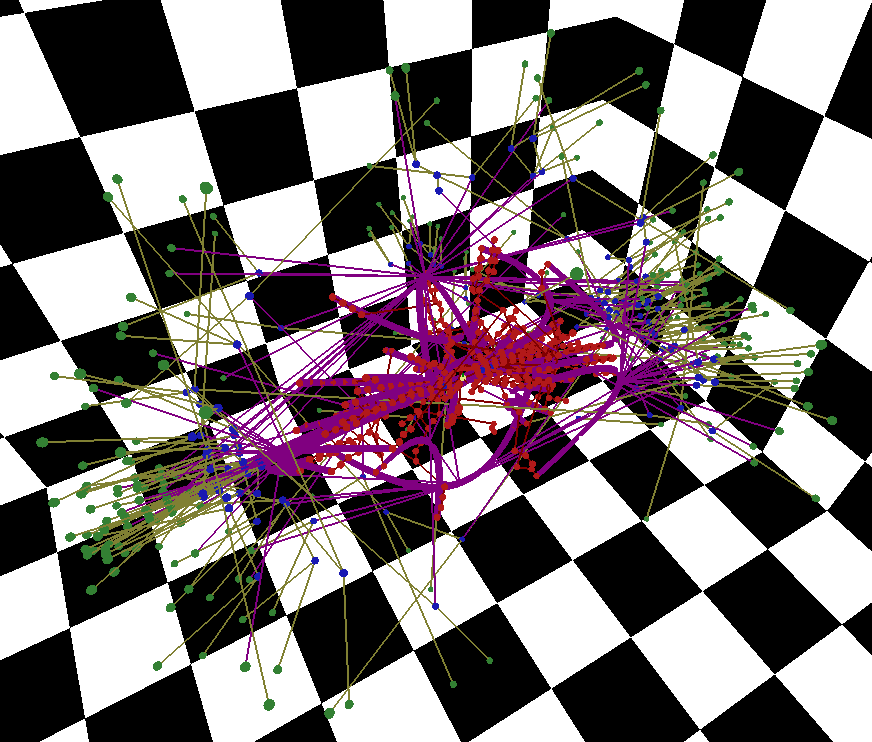Event class
On mothers and daughters
If you get confused by the different special-case storage options, the two
pythia.event.motherList(i)
and
pythia.event.daughterList(i)
methods are able to return a vector of all mother or daughter indices of particle i.
Two gluons back-to-back
Pythia8::Pythia pythia; ... //setup pythia.init(); Pythia8::Event &event = pythia.event; event.reset(); ... event.append( 21, 23, 101, 102, et, 0., 0., et); event.append( 21, 23, 102, 101, -et, 0., 0., et); ... if (!pythia.next()) continue; ... // analyze here
The 2nd argument to Event::append
| < code range > | < explanation > |
|---|---|
| 11 - 19 | beam particles |
| 21 - 29 | particles of the hardest subprocess |
| 31 - 39 | particles of subsequent subprocesses in multiple interactions |
| 41 - 49 | particles produced by initial-state-showers |
| 51 - 59 | particles produced by final-state-showers |
| 61 - 69 | particles produced by beam-remnant treatment |
| 71 - 79 | partons in preparation of hadronization process |
| 81 - 89 | primary hadrons produced by hadronization process |
| 91 - 99 | particles produced in decay process, or by Bose-Einstein effects |
Color lines - the 3rd ard col() and acol()
The colour flow information is based on the Les Houches Accord convention [1]. In it, the number of colours is assumed infinite, so that each new colour line can be assigned a new separate colour. These colours are given consecutive labels: 101, 102, 103, . . . . A gluon has both a colour and an anticolour label, an (anti)quark only (anti)colour. While colours are traced consistently through hard processes and parton showers, the subsequent beam-remnant-handling step often involves a drastic change of colour labels. Firstly, previously unrelated colours and anticolours taken from the beams may at this stage be associated with each other, and be relabelled accordingly. Secondly, it appears that the close space–time overlap of many colour fields leads to reconnections, i.e. a swapping of colour labels, that tends to reduce the total length of field lines.
[1] E. Boos et al., in the Proceedings of the Workshop on Physics at TeV Colliders, Les Houches, France, 21 May - 1 Jun 2001 hep-ph/0109068
PDG codes
Common PDG codes

Event classification codes
QCD processes from Pythia8.2 online docs
This is an example from PYTHIA output (SoftQCD on)
*------- PYTHIA Process Initialization --------------------------* | | | We collide p+ with p+ at a CM energy of 2.500e+03 GeV | | | |------------------------------------------------------------------| | | | | Subprocess Code | Estimated | | | max (mb) | | | | |------------------------------------------------------------------| | | | | non-diffractive 101 | 4.259e+01 | | A B -> A B elastic 102 | 1.576e+01 | | A B -> X B single diffractive 103 | 5.790e+00 | | A B -> A X single diffractive 104 | 5.790e+00 | | A B -> X X double diffractive 105 | 6.955e+00 | | A B -> A X B central diffractive 106 | 0.000e+00 | | | *------- End PYTHIA Process Initialization -----------------------*
Settings
Select SoftQCD...
This is from main04.cmnd
! 4) Settings for the hard-process generation. SoftQCD:all = on ! Allow total sigma = elastic/SD/DD/ND ! Optionally only study one or a few processes at a time. #SoftQCD:elastic = on ! Elastic #SoftQCD:singleDiffractive = on ! Single diffractive #SoftQCD:doubleDiffractive = on ! Double diffractive #SoftQCD:centralDiffractive = on ! Central diffractive #SoftQCD:nonDiffractive = on ! Nondiffractive (inelastic) #SoftQCD:inelastic = on ! All inelastic
An event
A hard PYTHIA event for a LHC energy

And a video
In the video the strings are also fat quadratic Bezier between two partons but the bending vertex is the collision 0,0,0 point - this is to illustrate the string tension/breaking better(?) (thin lines from a string connect to daughters) - the strength of bending is proportional to number of daughter particles.
Warning: size on disk 70MB